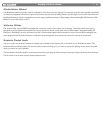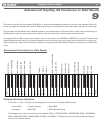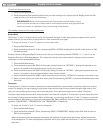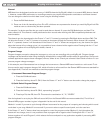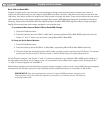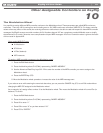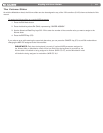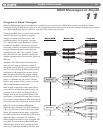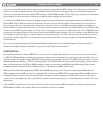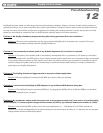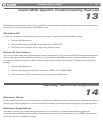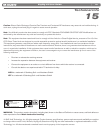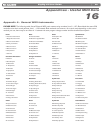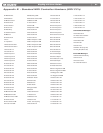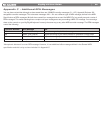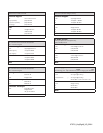
|
16
KeyRIg 49 User Guide
caninturncontain128possiblesoundsselectedviaaseparateprogramchangeMIDImessage.Thisenablesausertotheoretically
recallovertwomillionprogramsdirectly,usingonlyMIDIcommands.However,mostdevicesonlyuseafewdifferentbanks,and
allow you to access them with either a Bank LSB message or a Bank MSB message. Please consult your synthesizer’s or software’s
documentationformoreinformationonwhichtypeofbankchangemessagestheycanprocess.”
YouwillndmanyMIDIdevicesrespondtoprogramchangecommandsandmanyareorganizedaccordingtotheGMlisting.In
GeneralMIDIdevices,differentsoundsareorganizedinthesamewayfromdevicetodevice.Pianosoundsareintheirparticular
place, string sounds are in their place, drum sounds are in their place, and so on. All GM devices (both hardware and software
soundmodules)areclearlylabeledassuch,soyouknowthattheirsoundsareorganizedintheGeneralMIDIstructure.WhenaGM
devicereceivesaMIDIprogramchange,itcallsupatypeofsoundthatyouexpectfromtheGMsoundset.Allnon-GMMIDIsound
modulescallupuniquesoundsfromtheirmemoryuponreceivingMIDIprogramchanges.Sincethesoundsinanon-GMdeviceare
not arranged in a particular order, you need to take a look at the device itself to see which sound you want and at which location in
thememoryitresides.ManyVSTinstrumentssuchasNativeInstruments’FM7orthesynthmodulesinPropellerheadReasonare
non-GM devices.
You can send program change, bank LSB and bank MSB messages directly from the KeyRig keyboard. Please consult the
“AdvancedKeyRig49FeaturesinEditMode“sectionofthisUserGuideforfurtherdetails.
NRPN/RPNs
Non-registered parameter numbers (NRPN’s) are device-specific messages that enable you to control synths and sound modules
viaMIDI.TheMIDIspecicationdenesopenparameternumberstoallowmanufacturerstospecifytheirowncontrollers.Themore
commonoftheseareregisteredbytheMIDIManufacturer’sAssociationandarenowpartoftheMIDIspecication(hencetheterm
RegisteredParameterNumbers–RPN’s).(SeeAppendixB)EachNRPN/RPNhasanassociated2-bytenumber.Thetwobytes
allow for 128 values each. (An RPN or NRPN message is made up of two parts: the MSB and the LSB message. Both of these
messages together constitute an RPN or NRPN command.) This allows for 16,384 values in total.
MIDIcontrollers98and99representtheNRPNLSBandMSBrespectively,while100and101representtheRPNLSBand
MSBmessages(seetheMIDIcontrollerslistinAppendixB).TotransmitanNRPN/RPNmessage,theseLSBandMSBcontroller
messages are sent along with their user-specified values. A further controller message and value needs to be sent to specify the
(coarseorne)valueadjustment.Thisisspeciedbycontrollernumber6(dataentry)forcoarseadjustmentsornumber38forne
adjustments.
AlistofNRPN’sisusuallygivenintheuser’smanualofanydevicethatreceivesNRPNmessages.Itisalwaysnecessarythatthe
NRPN MSB and LSB be sent together. Both will be specified in the device’s manual.



